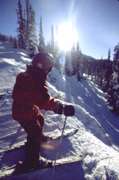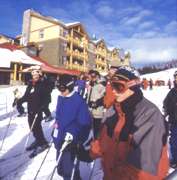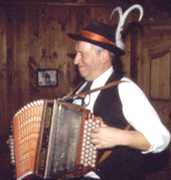Fernie and Kimberley aren't exactly household names, but if Canadian ski guru Charlie Locke works his usual magic, they will be soon. Unlike higher profile areas like Banff and Lake Louise, also part of Locke's six areas known as "Resorts of the Canadian Rockies," the British Columbia ski areas at Kimberly and Fernie are low-key and down-home. Each offers its own special style, off-slope fascinations, and varied terrain for downhill skiers and snowboarders.
| Fernie, located in the Lizard Range of the Canadian Rockies, is Canada's fastest growing ski area. It’s been adding muscle as it transforms into a world-class four-season resort since Locke purchased it in 1997. Ongoing developments include new high-speed chairlifts, elegant ski-in/ski-out lodging and an expanded array of groomed and glade runs on a generous 2,500 acres. Some are steep enough to juice an expert's adrenaline, while others provide intermediates with easy-glide cruisers. A caution: groomed trails are rated intermediate no matter how elevator-shaft steep the plunge. |
|
Non-ski hours are happily spent on the mountain, where the luxurious accommodations include several luxury lodges — Snow Creek, Lizard Creek, and Cornerstone. At the Lizard Creek Lodge we were favored with gourmet dinners and a lighted outdoor hot tub and pool.
A Town of Fascination
Fernie is truly a town of fascination. The area was discovered in 1873 by a prospector
seeking gold, instead finding coal. Even with its developing four-season tourism, Fernie
is still a mining town. In contrast with the upscale mountainside resorts and fantastic
log homes, the downtown fells like a trip back in time with traditional brick and stone
buildings, homey pubs, and the chalet-style courthouse.
Fernie's history is tied to a legend involving its founder, William Fernie. It's said
Fernie spied a necklace of shiny black stone on an Indian maiden, who was also the chief's
daughter. Fernie agreed to marry the maiden — if he was shown where the coal was
found. The chief agreed but Fernie reneged, so the angered chief placed a curse on the
valley. It worked. Fire destroyed part of downtown in 1904 and virtually the
entire town in 1908. The Elk River flooded in 1916, causing widespread devastation.
In the 1930s the region staggered through Depression and near famine.
|
|
Go Bavarian at Kimberley
Skiing off-piste is one of the allures at Kimberley Alpine Resort, located in British
Columbia's Purcell Mountains. Locke, who bought the resort in 1998, has injected $100
million Canadian into Kimberley's development. That's translated into 20 new runs, a
high-speed quad, an on-slope Marriott motel, learning areas for young skiers and
snowboarders, and a still expanding base village. The area spreads over 1,800 acres across
two mountains.
|
|
Locke is something of a local hero because Cominco, the mining company that once
employed 2,500 people, ended its Kimberley operations in late 2001. The burgeoning ski
resort is part of the community's survival plan. Like the city, the ski area is a
survivor. It began operations in 1933 with a ski jump. A rope tow was added in the 1950s
and chairlifts over the following decades, but financial woes resulted in the bank
threatening to close the area and sell its lifts and other assets. Instead, Kimberley's
mayor created a non-profit society that bought and operated the hill. As interest rates
declined and good snow years lured skiers, the debt was paid. Hoping to draw year-around
recreation and lure a well-financed developer, city leaders built a major golf course.
With Locke's purchase, their hopes were realized.
A Trove of Runs
Kimberley's slopes include a trove of runs, some moderate and others steep, some groomed,
others untouched. Skiing off-piste offers its own set of challenges — as well as
rewards.
 |
 |
 |
Like Fernie, part of Kimberley's allure is its town. Only a mile from the resort, the city is a western mining town with a Bavarian theme. That theme is best reflected at The Old Bauerhaus restaurant, originally built in 1640 near present day Munchen, Germany. The log building survived Europe’s Black Plague and served many purposes until it was restored in the mid-1750s and used as a barn. In 1987 it was taken apart, packed in containers, then shipped to Kimberley and reconstructed. It now serves sumptuous meals that feature choices liked baked Camembert, Swiss raclette, Wiener schnitzel, garlic prawns, seared medallions of venison, rolled potato dumplings, and apfelstrudel. After dining at the Bauerhaus, a vigorous day of skiing helps whet the appetite for another evening splurge, just as the Kimberley slopes whet the skiing appetite for its delicous glades and runs.
Click here for details to plan your own trip to Fernie and Kimberley.
Lee Juillerat
Photos by Larry Turner